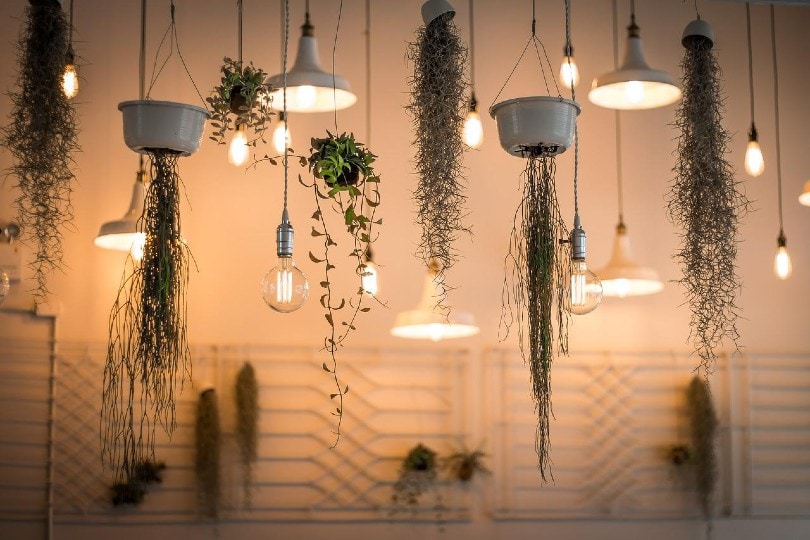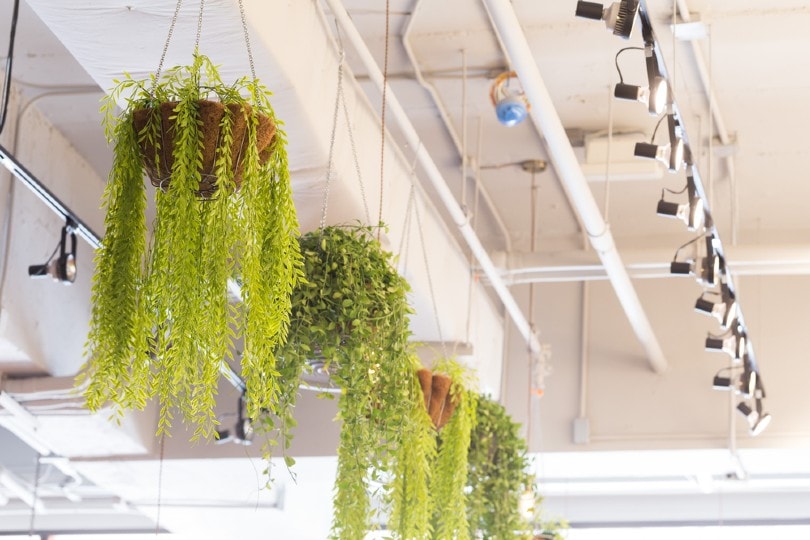How To Hang Plants From the Ceiling: 6 Tips & Tricks
-
Pete Ortiz
- Last updated:

House plants have become a popular trend in home décor, and not only do they provide a modern and calming aesthetic, but they can also help give your health a boost by purifying the air. While the greenery occupying every corner and shelf can look like a gorgeous indoor forest, it can take up too much space.
Hanging plants from your ceiling is a great way to save space while merging nature into your home, creating a green haven. There are a few options to hang your plants in a safe way that’s suitable to your living circumstances. You may be renting a home, and drilling holes into the ceiling may not be an option.
We have put together a few tips and tricks for you, but planning before you start can help ensure that your plant is secure and receives the proper amount of light to thrive
Before you start
Pick Your Plant
Choose a plant that will thrive in your specific environment, preferably low maintenance, to avoid reaching up or taking down your plants regularly. A draping or hanging plant is also a great choice, as they look gorgeous cascading down like a green waterfall. Choose a pet-friendly plant since some common indoor plants are toxic to dogs and cats.
- String of Pearls: These succulents grow over the edge of the pot like cascading beads and look great from high ceilings.
- Pathos: The pathos is a popular indoor plant, and when it is well watered and cared for, its leaves grow into long, creeping vines that are very effective for hanging.
- Spider plants: Spider plants are great indoor plants and are perfect for hanging pots, especially macrame hangers.
- Air Plants: Air plants are small plants that draw moisture from the air. They’re ideal for hanging because they don’t require soil and can be misted with a spray bottle for watering.
Choose the Best Pot
Lightweight plastic pots are an excellent choice for hanging plants, as long as they are pots that can drain as well. Rope plant hangers come in various styles and lengths, and plants look great hanging from them. Consider your aesthetic as well as how low you want the plant to hang from the ceiling.
Find the Right Location
Decide where in your home you would like your plant to hang. Keep in mind how much light your plant needs and how much light hits the spot that you choose. Some plants thrive in low light conditions, while some need a fair amount of light and will do well hanging in front of a south-facing window.
When you have chosen your plants and the hanger that will showcase them, all that’s left is to gather your materials and hang them up!

The 6 Tips & Tricks on How To Hang Plants From the Ceiling:
1. Choose the Right Hook
Choosing the right hook will depend on the size and weight of your plant and the type of ceiling you are hanging your plant from. A hook screw is the most common indoor hanging planter option. One end has a hook for hanging items, while the other has a screw installed into the stud or ceiling joists for a secure hold. A toggle bolt is another excellent option. On one end of a toggle bolt is a spring-loaded anchor, and on the other is a bolt. The anchor expands behind the ceiling to provide a firm grip. They work best on drywall or where a stud installation is not possible.
2. Install Your Hook According to Your Ceiling Material
Installing a plant hook directly into a stud or joist provides a firm grip. Drill your pilot hole slightly deeper than the threaded shaft’s length, insert the screw into the hole and tighten it until the hook’s base is flush with the ceiling. For drywall, because there is no beam or stud to drill into, a toggle bolt is best. Find a hollow spot in the ceiling and drill a hole the size of the top of the toggle bolt when it is closed. Insert the bolt through the hole by pinching the wings and tighten it until it is flush with the ceiling.
3. Use an Exposed Beam or Pipe and An S Hook to Avoid Drilling
An S-hook is a simple way to hang plants if you have exposed beams or pipes and don’t want to drill holes. Loop the S-hook around the pipe and hang the planter from the other end. The hooks are easily movable, giving you more creative flexibility with your hanging planter.

4. Use a Tension Rod or Curtain Rod to Avoid Drilling
If your house has a skylight or gaps with openings and you want to avoid drilling, you can use a curtain or tension rod to bridge the gap. The spring-operated rod comes with an internal spring, which you compress to install it. The spring is then held in place by placing the rod over the opening. Rubber caps at the ends protect the finish and can support the weight of several plants.
5. Use Magnetic Hooks for Exposed Metal Beams
If your apartment has exposed metal beams, a magnetic hook is a great way to hang your plant from the ceiling since it can hold the weight of your plant, and you can avoid drilling holes.
6. Use Adhesive Hooks or Suction Cup Hooks
If you intend to hang the plants from the ceiling, arrange the hooks vertically. All you need to do is clean the surface of dirt and dust. These hooks are ideal for lightweight plants and are a great alternative to drilling holes in the ceiling.
Final Thoughts
Hanging a plant from the ceiling can make your room feel warm and inviting without cluttering the corners or shelf space, but it also doesn’t always mean you need to drill a hole. Spend time locating a ceiling joist for optimal strength and finding a spot with an adequate amount of sun for the plant you chose. Whether you want to make a floating garden with several hanging plants or one cascading piece that steals the attention of the room, you can be confident that your hanging planters are safely and effectively installed.
- https://www.insider.com/guides/home/how-to-hang-plants-from-the-ceiling
- https://www.masterclass.com/articles/how-to-hang-houseplants-from-the-ceiling
- https://plantly.io/plant-care/how-to-hang-plants-from-a-ceiling-without-drilling/
- https://www.wayfair.co.uk/sca/ideas-and-advice/guides/how-to-hang-plants-from-the-ceiling-T11576
Featured Image Credit: Pexels, Pixabay
Contents


